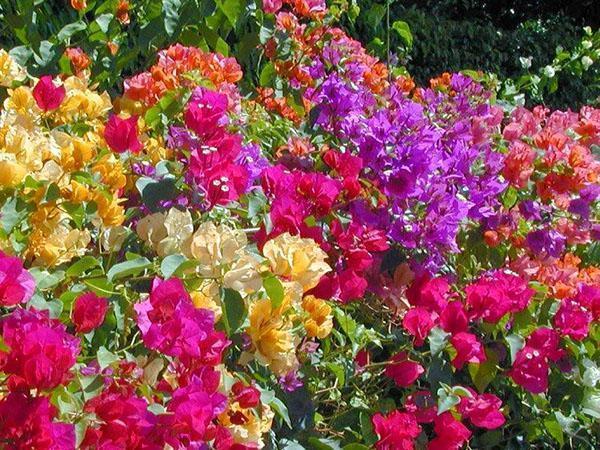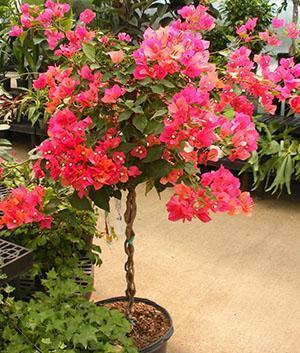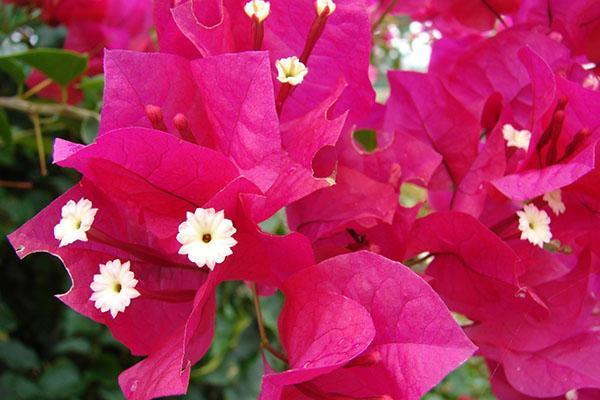Descriptions and photos of popular bougainvillea varieties
 In the tropics and subtropics of South America, where bougainvillea grows, the culture can climb many meters in height and braid the walls of houses. Some varieties of this spectacular plant take on the appearance of lush flowering trees covered with thorns of powerful vines or modest shrubs.
In the tropics and subtropics of South America, where bougainvillea grows, the culture can climb many meters in height and braid the walls of houses. Some varieties of this spectacular plant take on the appearance of lush flowering trees covered with thorns of powerful vines or modest shrubs.

Of the naturally occurring bougainvillea species in amateurs ornamental plants the most popular are beautiful bougainvillea and naked bougainvillea. In addition, there are many interspecific hybrids, as well as cultivated forms and varieties of the most amazing colors.
Beautiful bougainvillea (Bougainvillea spectabilis)
 This type of plant has an incredible growth rate and often looks like a large, up to 15 meters high, liana. As with all bougainvillea species, the leaves of this variety are heart-shaped, pointed. The back side is covered with a small pile, the autumn leaf plates are dense, durable. In the photo of bougainvillea, in addition to leaves and curved thorns, bright bracts are clearly visible. Bougainvillea flowers, opening from April to mid-autumn, are collected in paniculate inflorescences at the ends of the branches. A group of two or three stipules surrounds 1 to 3 true flowers.
This type of plant has an incredible growth rate and often looks like a large, up to 15 meters high, liana. As with all bougainvillea species, the leaves of this variety are heart-shaped, pointed. The back side is covered with a small pile, the autumn leaf plates are dense, durable. In the photo of bougainvillea, in addition to leaves and curved thorns, bright bracts are clearly visible. Bougainvillea flowers, opening from April to mid-autumn, are collected in paniculate inflorescences at the ends of the branches. A group of two or three stipules surrounds 1 to 3 true flowers.
Bougainvillea glabra
 This type of bougainvillea, in the photo, is much smaller. Its maximum height is only five meters, which makes it possible to use the plant as a room culture. This is facilitated by the fact that the plant tolerates pruning almost painlessly and can be formed at the request of the owner.
This type of bougainvillea, in the photo, is much smaller. Its maximum height is only five meters, which makes it possible to use the plant as a room culture. This is facilitated by the fact that the plant tolerates pruning almost painlessly and can be formed at the request of the owner.
 An example of this is the bougainvillea Sanderian shown in the photo, an old variety tested by gardeners around the world.
An example of this is the bougainvillea Sanderian shown in the photo, an old variety tested by gardeners around the world.
Unlike bougainvillea beautiful, this species has completely smooth leaves, and flowering occurs in spring and early summer. The range of colors is incredibly wide, which is facilitated by active selection work. It was bougainvillea naked, cultivated back in 1861, that became the basis for obtaining a great variety of hybrid and varietal plants that adorn gardens, parks and window sills today.
 Another variety is Alexandra bougainvillea, ideal for compact indoor compositions and creating original garden sculptures. True, in Russian conditions in the open field, this beautiful liana takes root only in the southern regions, since it does not tolerate frosts below -8 ° C.
Another variety is Alexandra bougainvillea, ideal for compact indoor compositions and creating original garden sculptures. True, in Russian conditions in the open field, this beautiful liana takes root only in the southern regions, since it does not tolerate frosts below -8 ° C.
Bougainvillea peruviana (Bougainvillea peruviana)
 This species is not often found in ornamental plantings, but bougainvillea, discovered in 1810, became famous for its hybrids with other plant varieties. Breeders were attracted by the culture's unusual ability to bloom several times a year after natural or artificial drought.
This species is not often found in ornamental plantings, but bougainvillea, discovered in 1810, became famous for its hybrids with other plant varieties. Breeders were attracted by the culture's unusual ability to bloom several times a year after natural or artificial drought.
In nature, plants of this species are extremely reluctant to branch, therefore bougainvillea, as in the photo, often forms spectacular cascading shoots.
Most of all modern bougainvillea varieties are obtained from a hybrid accidentally seen in the garden.The plant was named after its owner, Bougainvillea × buttiana, and is classified as a hybrid of Bougainvillea glabella and Peruvian.
Popular bougainvillea varieties
Varietal bougainvilleas are strikingly different from each other in size, shape and color of bracts.
The simplest, but very effective and popular among flower growers are bougainvillea varieties with the usual monochromatic bracts and rich green foliage.
One of the most common varieties, bougainvillea Sanderian pleases the eye with lush purple bracts, lends itself well to shaping and is quite unpretentious at home.
 She matches the bougainvillea of the Vera Deep Purple variety shown in the photo. The plant stands out with densely crimson bracts, densely covering the ends of young shoots. No less impressive is the appearance of bougainvillea flowers of the Glabra Donker and New Violet varieties, also revealing large purple-purple bracts.
She matches the bougainvillea of the Vera Deep Purple variety shown in the photo. The plant stands out with densely crimson bracts, densely covering the ends of young shoots. No less impressive is the appearance of bougainvillea flowers of the Glabra Donker and New Violet varieties, also revealing large purple-purple bracts.
The bougainvillea varieties Cypheri, Australian Pink and Donya are a godsend for a grower who prefers plants with pink bracts. Moreover, in the latter case, flowering does not stop almost all year round.
 The bougainvillea varieties Crimson Lake, Black India Red and Tomato Red presented in the photo captivate with all shades of red, purple, raspberry and burgundy.
The bougainvillea varieties Crimson Lake, Black India Red and Tomato Red presented in the photo captivate with all shades of red, purple, raspberry and burgundy.
 Blooming looks unusually sunny against the background of green foliage bUgenville Golden Tango with large yellow bracts and very small true flowers.
Blooming looks unusually sunny against the background of green foliage bUgenville Golden Tango with large yellow bracts and very small true flowers.
The bougainvillea group with simple white bracts is represented by the variety Jamaica White, which is distinguished by the abundance and duration of flowering, as well as Mrs Alice and Penelope.
 The original bougainvillea Lateritia can not be overlooked due to the bright salmon color of the bracts, shimmering in the sun in all shades of orange and pink.
The original bougainvillea Lateritia can not be overlooked due to the bright salmon color of the bracts, shimmering in the sun in all shades of orange and pink.
Terry bougainvillea varieties
Terry varieties are famous for especially dense caps at the ends of the shoots and for exceptional decorativeness. A photo of bougainvilleas from the Double varietal group, which includes plants with white, salmon, pale pink, purple, red and orange stipules, is always a reason for the admiration and envy of many flower growers.
 Bougainvillea Double Lilarose is surprisingly sensual shades of pink, salmon and lilac combined with a long flowering period and relative unpretentiousness. Also interesting is Double Pink boughervillea, which differs from the first representative of the group in more gentle tones and a slightly greenish base of stipules.
Bougainvillea Double Lilarose is surprisingly sensual shades of pink, salmon and lilac combined with a long flowering period and relative unpretentiousness. Also interesting is Double Pink boughervillea, which differs from the first representative of the group in more gentle tones and a slightly greenish base of stipules.
 Luxurious caps of juicy raspberry bracts on Double Red bougainvillea will be a discovery for novice florists and will not leave indifferent those already connoisseurs of this tropical culture.
Luxurious caps of juicy raspberry bracts on Double Red bougainvillea will be a discovery for novice florists and will not leave indifferent those already connoisseurs of this tropical culture.
Terry flowering is not the limit of the capabilities of a unique flower.
Photo of bougainvillea with multi-colored bracts
Today, at the disposal of fans of indoor and garden floriculture varieties, which fully reveal the ability of the bracts of this plant to change color over time.
 Bracts of bougainvillea varieties Bois De Roses are orange at first, but gradually change color, becoming deep pink. A similar picture is observed during the flowering of the Thai Gold variety. This bougainvillea shown in the photo in the early days seems golden-orange, but at the time of wilting of the bracts, they become completely ruddy pink.
Bracts of bougainvillea varieties Bois De Roses are orange at first, but gradually change color, becoming deep pink. A similar picture is observed during the flowering of the Thai Gold variety. This bougainvillea shown in the photo in the early days seems golden-orange, but at the time of wilting of the bracts, they become completely ruddy pink.
Similar metamorphoses occur with many plant varieties and hybrids. Initially, white bracts take on pink tones, red-orange become crimson or purple. Skillfully combining specimens with such extraordinary properties, you can turn a garden into something constantly changing, but always beautiful.
Even more surprising are the bougainvillea varieties, on which two-colored bracts appear at the same time or their shades differ significantly on different branches.
 Strawberry Lace is a plant with pink and white stipules that can only be compared to fresh strawberries and cream. On the stipules of Mary Palmer bougainvillea, the shades are softer and softer.On the main white background, strokes of lilac and lavender look very beautiful.
Strawberry Lace is a plant with pink and white stipules that can only be compared to fresh strawberries and cream. On the stipules of Mary Palmer bougainvillea, the shades are softer and softer.On the main white background, strokes of lilac and lavender look very beautiful.
Variegated bougainvillea varieties
A special place is occupied by varieties in which, in addition to bright, and sometimes multi-colored bracts, two shades are combined on the foliage.
 Most of these plants are the result of spontaneous mutation, therefore, offspring can only be obtained from them vegetatively with the help of cuttings and layering.
Most of these plants are the result of spontaneous mutation, therefore, offspring can only be obtained from them vegetatively with the help of cuttings and layering.
 Bougainvillea San Diego Red Variegata has red bracts, which, against the background of light golden-green foliage, seem even more catchy and defiant.
Bougainvillea San Diego Red Variegata has red bracts, which, against the background of light golden-green foliage, seem even more catchy and defiant.
 Delta Dawn's salmon or golden bougainvillea bracts look like real gold against bluish green foliage and bright white edging.
Delta Dawn's salmon or golden bougainvillea bracts look like real gold against bluish green foliage and bright white edging.
In addition to golden or white spots on the leaves of bougainvillea, you can also see pink tones. An example of this is the beautiful Raspberry Ice variety with carmine bracts and decorative foliage, as if toasty around the edge.